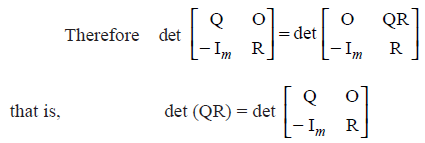Nullity Of A Matrix
NULLITY OF A MATRIX: If Q is an n by n matrix then QX = 0 has a non trial solution X ≠ 0 if and only if Q is singular, that is ; det Q = 0. The set of all vectors X that satisfy QX = 0 forms a vector space called the null space of matrix Q. The rank of the null space is called the nullity of Q.
Rank of Q nullity of Q = n
When Q is not square but a k by n matrix, k < n.
Theorem . (Binet-Cauchy Theorem)
If Q and R are k by m and m × k matrices respectively with k < m then the determinant of the product det (QR) = the sum of the products of corresponding major determinants of Q and R.
Proof. To evaluate det (QR), let us devise and multiply two (m k) by (m k) partitioned matrices

where Im and Ik are identity matrices of order m and k respectively.
 ...................(1)
...................(1)
Let us now apply Cauchy’s expansion method to the right-hand side of equation (1), and observe that the only non-zero minors of any order in matrix – Im are its principal minors of that order. We thus find that the Cauchy expansion consists of these minors of order m – k multiplied by their cofactors of order k in Q and R together.
Theorem . (Sylvester’s Law)
If Q is a k by n matrix and R is an n by P matrix then the nullity of the product cannot exceed the sum of the nullities of the factors, that is ;
nullity of QR ≤ nullity of Q nullity of R ...(1)
Proof. Since every vector x that satisfies RX = 0 must certainly satisfy QRx = 0
We have nullity of QR ≥ nullity of R ≥ 0 ...(2)
Let s be the nullity of matrix R. Then there exists a set of s linearly independent vectors {x1, x2, ..... xs} forming a basis of the null space of R.
Thus Rxi = 0 for i = 1, 2, ....., s ...(3)
Now let s t be the nullity of matrix QR. Then there must exist a set of t linearly independent vectors
{xs 1, xs 2, ...... xs t} such that the set {x1, x2, ..... xs, xs 1, xs 2, xs t} forms a basis for the null space of matrix QR.
Thus QRxi = 0, for i = 1, 2, ..... s, s 1, s 2, ...... s t ...(4)
In otherwords, of the s t vectors xi forming a basis of the null space of QR, the first s vectors are sent to zero by matrix R and the remaining non-zero Rxi’s (i = s 1, s 2, ...... s t) are sent to zero by matrix Q.
Vectors Rxs 1, Rxs 2, ....... Rxs t are linearly independent ; for if 0 = a1 Rxs 1 a2 Rxs 2 ...... at Rxs t = R(a1xs 1 a2xs 2 ....... at xs t) then vector (a1 xs 1 a2 xs 2 ....... at xs t) must be the null space of R, which is possible only if a1 = a2 = ......... = at = 0.
Thus we have found that there are at least t linearly independent vectors which are sent to zero by matrix Q and therefore nullity of Q ≥ t.
But since t = (s t) – s
= nullity of QR – nullity of R, equation (1) follows.
Substituting equation, rank of Q nullity of Q = n into equation (1), we find that
rank of QR ≥ rank of Q rank of R – n ...(5)
Furthermore, in equation (5) if the matrix product QR is zero, then rank of Q rank of R ≤ n.